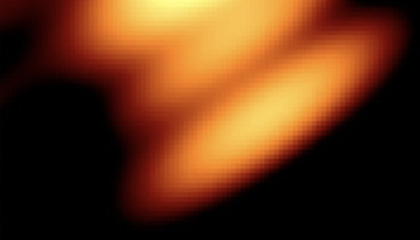Science
Researchers Capture First Image of Two Orbiting Black Holes

A groundbreaking study has unveiled the first-ever image of two black holes orbiting each other, offering new insights into a celestial mystery that has captivated astronomers since the 19th century. This remarkable achievement was made possible through the collaboration of the Event Horizon Telescope (EHT) team and researchers from various institutions, including the University of Arizona and Harvard University.
The black holes, located in the Milky Way galaxy, are positioned approximately 1,500 light-years from Earth. The image reveals a striking visual representation of the gravitational dance between these massive entities, providing a clearer understanding of their dynamics and the processes governing their behavior. The findings were published in a study released on March 15, 2024.
Significant Milestone in Astrophysics
Researchers have long hypothesized about the existence of black holes and their interactions. The new image serves as a pivotal confirmation of these theories. According to the National Science Foundation, the EHT’s ability to capture this unprecedented view highlights significant advancements in astrophysical research.
Dr. Maria Lopez, a lead researcher on the project, remarked, “This image not only showcases the intricate relationship between these two black holes, but it also opens the door for further exploration into how they influence their surrounding environments.” The research team utilized a network of radio telescopes around the globe to achieve the high-resolution image, marking a major technological feat in the field.
The study’s findings have implications beyond mere observation. By analyzing the orbiting black holes, scientists can glean insights into the fundamental properties of black holes themselves, as well as the nature of gravity and spacetime. Understanding these cosmic giants helps refine models of galaxy formation and evolution.
Continued Exploration of the Cosmos
This image is the latest milestone in ongoing efforts to unravel the complexities of the universe. Since the first image of a black hole was captured in 2019, researchers have intensified their focus on understanding the roles these enigmatic entities play in cosmic structures. The EHT team continues to refine its techniques, aiming for even greater clarity in future observations.
The implications of this discovery extend to the broader scientific community as well. As researchers build on this foundational work, the hope is to answer lingering questions about dark matter, energy, and the overall composition of the universe. The collaboration between institutions like Harvard University and the University of Arizona demonstrates a commitment to international scientific cooperation, pushing the boundaries of knowledge in astrophysics.
In summary, the successful imaging of two orbiting black holes marks a significant advancement in our understanding of the universe. With ongoing research and collaboration, the mysteries of these cosmic giants are gradually being unveiled, paving the way for future discoveries that could fundamentally alter our understanding of the cosmos.
-

 Science2 months ago
Science2 months agoInventor Achieves Breakthrough with 2 Billion FPS Laser Video
-

 Health2 months ago
Health2 months agoCommunity Unites for 7th Annual Into the Light Walk for Mental Health
-

 Top Stories2 months ago
Top Stories2 months agoCharlie Sheen’s New Romance: ‘Glowing’ with Younger Partner
-

 Entertainment2 months ago
Entertainment2 months agoDua Lipa Aces GCSE Spanish, Sparks Super Bowl Buzz with Fans
-

 Health2 months ago
Health2 months agoCurium Group, PeptiDream, and PDRadiopharma Launch Key Cancer Trial
-

 Top Stories2 months ago
Top Stories2 months agoFormer Mozilla CMO Launches AI-Driven Cannabis Cocktail Brand Fast
-

 World2 months ago
World2 months agoIsrael Reopens Rafah Crossing After Hostage Remains Returned
-

 Entertainment2 months ago
Entertainment2 months agoMother Fights to Reunite with Children After Kidnapping in New Drama
-

 World2 months ago
World2 months agoR&B Icon D’Angelo Dies at 51, Leaving Lasting Legacy
-

 Business2 months ago
Business2 months agoTyler Technologies Set to Reveal Q3 Earnings on October 22
-

 Health2 months ago
Health2 months agoYouTube Launches New Mental Health Tools for Teen Users
-

 Health2 months ago
Health2 months agoNorth Carolina’s Biotech Boom: Billions in New Investments








